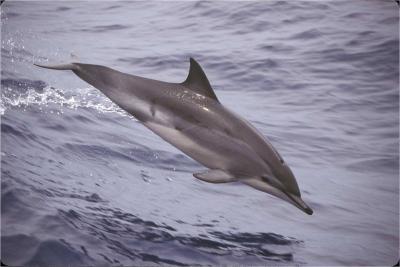The clymene dolphin is a small and sleek marine mammal living in the Atlantic Ocean. A new study has found this dolphin is a rarity in mammals - a genetic hybrid that is closely related to spinner and striped dolphins.
The classification of the clymene dolphin has been a longstanding challenge to taxonomists, who initially considered it to be a subspecies of the spinner dolphin. Then in 1981, thorough morphological analyses established it as a recognized distinct species.
In the current study, researchers sought to clarify outstanding questions about the dolphin's origin and relationships with rigorous genetic analyses. Based on research conducted at the American Museum of Natural History's Sackler Institute for Comparative Genomics, the authors examined the nuclear and mitochondrial DNA from skin samples obtained from both free-ranging dolphins by means of biopsy darts and deceased dolphins obtained through stranding events. Using samples from 72 individual dolphins (both clymene dolphins and the closely related spinner and striped dolphins), the researchers amplified one mitochondrial DNA marker and six nuclear DNA markers as a means of analyzing the evolutionary relationship between the clymene dolphin and its closest relatives.

The Clymene dolphin is a result of ancient, random genetic modification - hybridization between two closely related dolphins species, the spinner dolphin and the striped dolphin. Credit: R. Pitman
The level of discordance among the nuclear and mitochondrial markers from the three species, the authors assert, is best explained as an instance of natural hybridization. Specifically, the team discovered that while the mitochondrial genome of the clymene dolphin most resembled the striped dolphin, the nuclear genome revealed a closer relation to the spinner dolphin. The authors also noted that continued hybridization may still occur, although at low levels.
Number of Stenella clymene, S. coeruleoalba and S. longirostris specimens sequenced for this study. Link and credit: doi:10.1371/journal.pone.0083645
"Our study represents the first such documented instance of a marine mammal species originating through the hybridization of two other species," said Ana R. Amaral, lead author of the study and research associate at the American Museum of Natural History. "This also provides us with an excellent opportunity to better understand the mechanisms of evolution."
"With its similar physical appearance to the most closely related species, our genetic results now provide the key insights into this species origin" said senior author Dr. Howard Rosenbaum of the Wildlife Conservation Society and American Museum of Natural History. "Very little is known about the clymene dolphin, whose scientific name translated from Greek is oceanid, but ironically also can mean fame or notoriety. Hopefully, our work will help draw greater attention to these dolphins in large parts of their range."





Comments